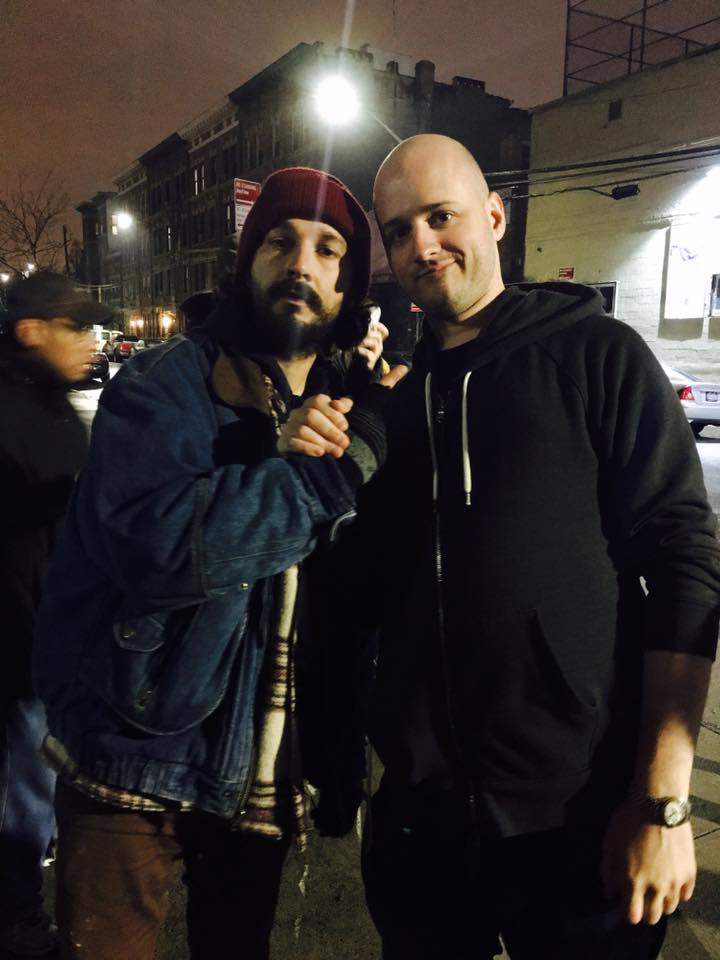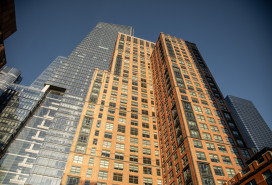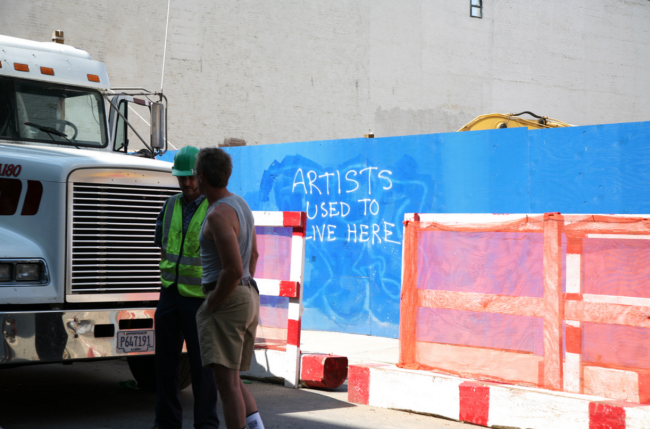Astoria locals on what it was like to live near Shia LaBeouf's "He Will Not Divide Us" installation

Last month, as Donald Trump was inaugurated as president, a new art installation went up at the Museum of the Moving Image in Astoria. He Will Not Divide Us invited the public to come to a lot behind the museum, where a white wall inscribed with the titular phrase stood; an attached video camera delivered a live feed of whomever happened to show up to this now-defunct website.
Visitors were encouraged to repeat the phrase "He will not divide us," which the exhibit's creators—actor Shia LaBeouf and artists Nastja Säde Rönkkö and Luke Turner—described as "a show of resistance or insistence, opposition or optimism, guided by the spirit of each individual participant and the community."
Their intention was to have the live feed operate continuously for the duration of Donald Trump's presidency, but it was shut down by the museum after only 20 days. And the reasoning behind the exhibit's premature closure reveals what can happen when political art is placed in residential city neighborhoods.
In addition to providing a forum for visitors to voice the suggested mantra, the exhibit also attracted a wide range of people who used the broadcast to suit their own agendas. Some held forth on politics, others promoted their social media feeds and personal projects, and plenty more used it as a gathering place to hang out, play music, dance, and have their conversations beamed to the world, reality TV-style. I live nearby, and when I dropped by one night, I found a group of students—perhaps from the Frank Sinatra School of the Arts around the corner—chatting and eating pizza in front of the camera. (Someone offered me a slice.)
More troubling, however, than converting an art exhibit into their own version of Big Brother, is how some visitors converged on He Will Not Divide Us to espouse white supremacist ideologies, leading to conflict with the visitors who oppose Trump. LaBeouf, who was regularly in attendance, was arrested after an altercation with one such attendee; another regular, a Brooklyn-based performance artist, told VICE that he was scared for his life after receiving death threats in response to his presence on the live feed.
Per VICE, threads about the exhibit popped up on Internet forums like 4chan, where trolls were egged on to head to Astoria. Whether their apparent far-right sentiments were genuine or just an attempt to provoke, conflicts between visitors began to escalate, as several YouTube captures of the live feed reveal.
More than once, police put up barricades to temporarily bar access to the exhibit.
On February 10, the Museum of the Moving Image shut it down for good, citing safety concerns. In an official statement, a museum spokesperson said "the installation had become a flashpoint for violence and was disrupted from its original intent... there have been dozens of threats of violence and numerous arrests, such that police felt compelled to be stationed outside the installation 24 hours a day, seven days a week."
Not the first time
This outcome recalls other performance art in which visitors are given a blank slate to make the work their own. In her 1974 piece Rhythm 0, for instance, Marina Abramović stood still and invited onlookers to use any of 72 objects, ranging from a pen to a loaded gun, on her body. According to The Art Story, over the course of six hours, the audience divided into factions, some of which sought to protect the artist, while others inclined toward violence. One guest held the gun to her head.
Though He Will Not Divide Us was on a primarily commercial block, it was also close to two high schools and an elementary/junior high school, as well as a number of restaurants. And as a part of the Kaufman Arts District, the area receives plenty of foot traffic from both tourists and locals. Given the fact that He Will Not Divide Us was becoming a rallying point for people on opposing ends of the political spectrum, not to mention apparent white supremacists and Neo-Nazis, it seems understandable that the museum wanted to avoid playing host to a potential powder keg.
Is the cancellation an overreaction?
But some Astoria residents are dubious about how dangerous the situation really was. Will Juseck lives nearby, and says he enjoyed the installation‚ even its less savory elements—and is disappointed that it's no longer open.
"I walked by it almost every day, and I never felt endangered a single time," he says, dismissing the exhibit's more provocative attendees as just trolls.
And many of them did seem to be just that. Shortly before the installation was closed, I watched several men in what seemed to be a heated argument on the live feed. One, a Trump supporter, said that he objected to an anti-Trump visitor's relentless self-promotion. As they raised their voices, I turned off the video. But 15 minutes later, when I checked back in, they were bonding over their shared love of 1990s video games. (One potential upside of such a gathering place may be allowing very different people to find unexpected common ground.)

Still, many residents did find the enterprise disconcerting: Anthony Volpe, who also lives in the neighborhood, said he felt troubled by some of the people He Will Not Divide Us attracted. "I was disturbed to hear that it became an alt-right, Neo-Nazi hang out and I actually made a point to avoid walking by there for that reason," he says.
As for what this might suggest about his neighbors, Volpe thinks that most of the far-right visitors don't actually hail from Astoria. "I think it just became an area of resistance among the far-right," he says.
Despite the fact that this group will no longer be drawn to the neighborhood, Volpe thinks that the museum's closure of the exhibit isn't necessarily good news. He points out that the early shut down could be seen as buckling to pressure from hate groups.
"While I understand the security concerns, it sends a bad message that these guys, and let's be clear, they are primarily men, can intimidate a diverse community like Astoria," he says. "It's a small victory, but a victory nonetheless, for the far-right and its sympathizers."
You Might Also Like




























